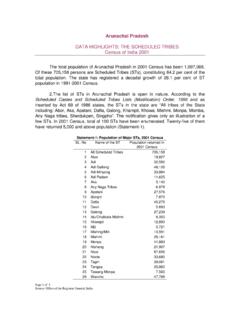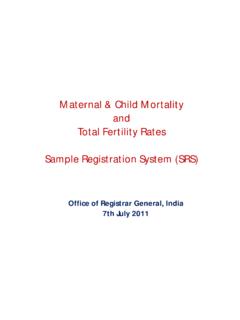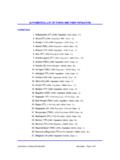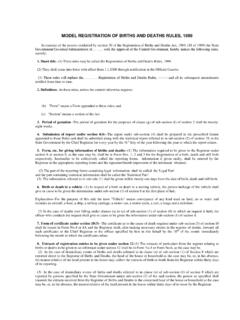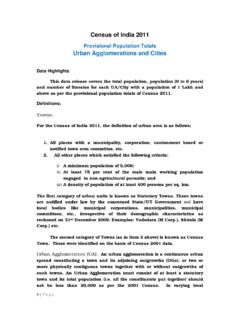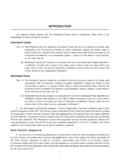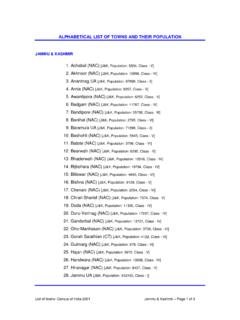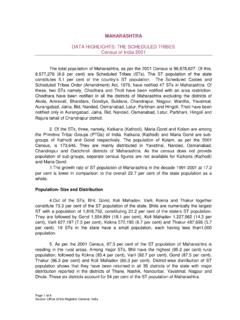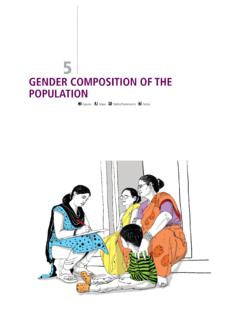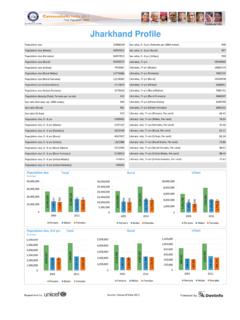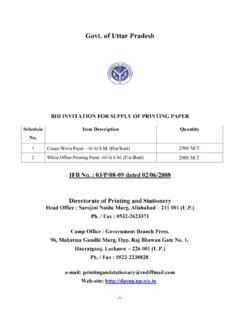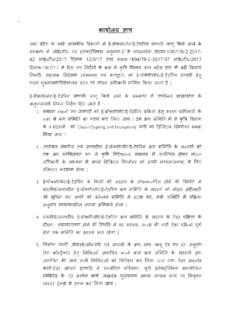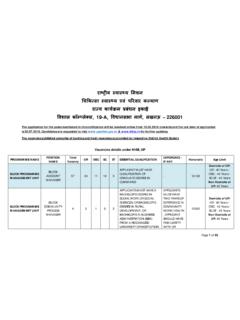Transcription of UP SC comments - 2011 Census of India
1 Page 1 of 5 Source: Office of the Registrar General, India uttar pradesh DATA HIGHLIGHTS: THE SCHEDULED CASTES Census of India 2001 uttar pradesh is the most populous State of India . The State was bifurcated by transferring thirteen (13) districts to form the State of Uttaranchal , and now Uttarakhand, the 27th State of Indian Union on 8th November, 2000. Scheduled Caste (SC) population of uttar pradesh is 35,148,377 at 2001 Census , constituting percent of the total population (166,197,921) of the State. uttar pradesh holds 1st rank and 4th rank in terms of absolute number of SC population and its proportion to total population respectively among all the States and UTs.
2 The decennial growth of SC population has been per cent, which is comparable with the growth of total population ( per cent) of the State. The State has a total of sixty six (66) SCs; all of them have been enumerated at 2001 Census . Scheduled Castes are predominantly rural as per cent of them live in villages. District - wise distribution of SC population shows that they have the highest concentration in percentage term in Sonbhadra district ( per cent), followed by Kaushambi ( per cent) and Sitapur ( per cent) districts.
3 Baghpat has the lowest proportion of SC population (11per cent). Population - Size & Distribution of sixty six (66) SCs, Chamar has the highest number (19, 803,106) constituting per cent of the total SC population. Pasi is the second largest SC having a population of 5,597,002, forming per cent of the SC population. Three other SCs in the descending order are Dhobi, Kori and Balmiki. Alongwith Chamar and Pasi, these five SCs constitute per cent of the total SC population. Gond, Dhanuk and Khatik have population in the range of 443,457 to 764,765 and together form another 5 per cent.
4 Nine SCs, viz. Rawat, Baheliya, up to Kol with the population ranging from 109,557 to 331,374, constitute per cent; the remaining forty nine (49) SCs along with the generic castes constitute the balance 3 per cent of the State s SC population. As many as seventeen (17) SCs have population below 5000. Of them, four SCs, namely, Gharami, Lalbegi, Bajgi and Khorot are very small, each having population less than 1000. the level of the individual caste, Chamar are primarily concentrated in Azamgarh, Jaunpur, Agra, Bijnor, Saharanpur, Gorakhpur and Ghazipur districts.
5 Pasi have the highest number in Sitapur district, followed by Rae Bareli, Hardoi and Allahabad districts. Other three major groups, namely, Dhobi, Kori and Balmiki have maximum population in Bareilly, Sultalpur and Ghaziabad districts respectively. Page 2 of 5 Source: Office of the Registrar General, India 2 Sex Ratio overall sex ratio of the SC population in uttar pradesh is 900 females per 1000 males which is lower than the national average of 936 for all SCs.
6 7. Among numerically larger SCs, Chamar and Kori have registered overall sex ratio below 900, whereas Pasi and Dhobi have sex ratio above 900. Statement - 1 : Sex Ratio Age group All SCs ( India ) All SCs (State) Pasi Dhobi Balmiki Chamar Kori All ages 936 900 919 908 900 893 889 0 - 6yrs. 938 930 951 921 918 923 928 sex ratio in the age group 0-6 years (930) is slightly lower than that of the SCs at the national level (938).
7 Among the larger groups, Pasi have the highest and Balmiki have the lowest child sex ratio. Except Pasi, four other major SCs have returned lower child sex ratio lower if compared with that of the national average. Literacy & Educational Level overall literacy rate of the SCs has increased from per cent at 1991 Census to per cent at 2001 Census . Despite improvement, the literacy rate has been considerably lower than the national average ( per cent) aggregated for all SCs. Male and female literacy rates ( per cent and per cent respectively) among the SCs are also lower than those recorded for all SCs at the national level ( per cent & per cent respectively).
8 The major SCs, Chamar and Dhobi have shown the highest literacy rate (49 per cent), while Pasi have recorded the lowest literacy rate. Similar trend has been registered for these castes in respect of female literacy also. Statement -2 : Literacy Rate Literacy rate All SCs Chamar Dhobi Balmiki Kori Pasi Persons Females the SC literates, 38 per cent are either without any educational level or have attained education below primary level. The proportions of literates who have attained education up to primary and middle levels are per cent and per cent respectively.
9 Literates who are educated upto matric/higher Page 3 of 5 Source: Office of the Registrar General, India 3 secondary per cent. Graduates & above are 3 per cent. The non-technical & technical diploma holders constitute a meagre per cent only. Statement 3 : Levels of Education among the major Scheduled Castes Educational levels attained Names of SCs Literate without educational level Below primary Primary Middle Matric/Secondary/ Higher Secondary/ Intermediate etc. Technical & Non-technical diploma etc. Graduate and above All SCs Chamar Pasi Dhobi Kori Balmiki is a sharp decline in the percentage of literates from the secondary level onwards.
10 The percentage of matriculate is almost half of the middle level literates. The proportion of matriculates ( per cent) decline to one third in graduation level and above. of the total 133 lakh SC children in the age group 5 -14 years, lakh have been attending school constituting per cent. As many as lakh children in the corresponding age group have not been going to school. Among the major SCs, Chamar and Dhobi have 60 per cent school going children. This proportion is 51 57 per cent among Pasi, Balmiki and Kori.
